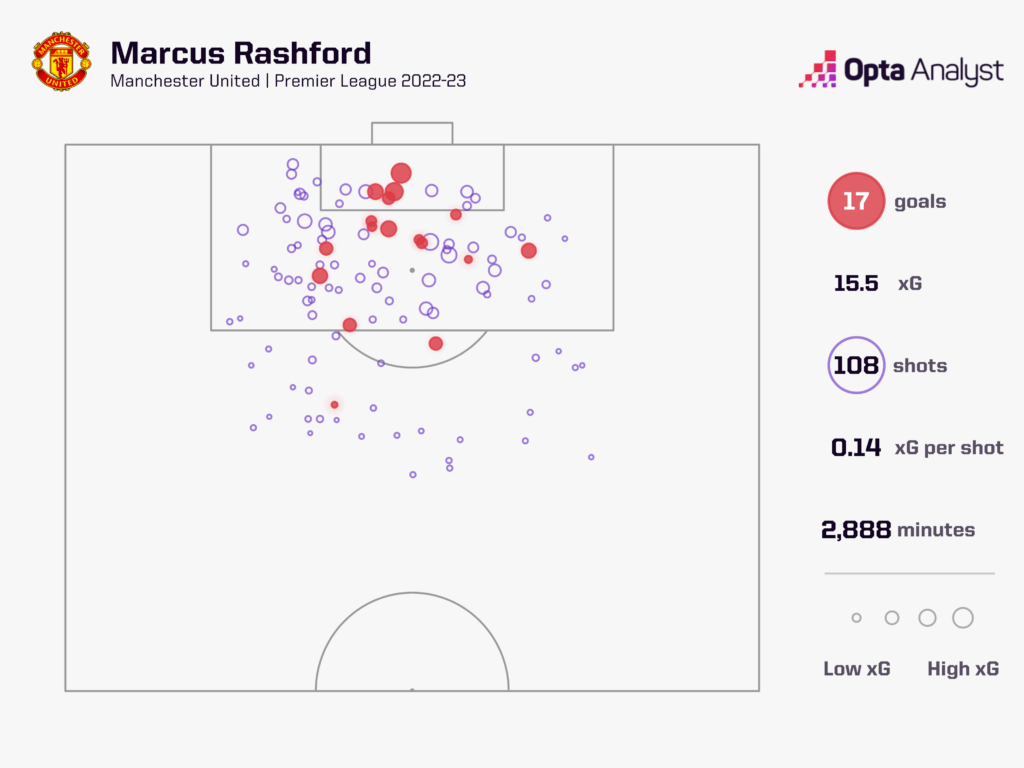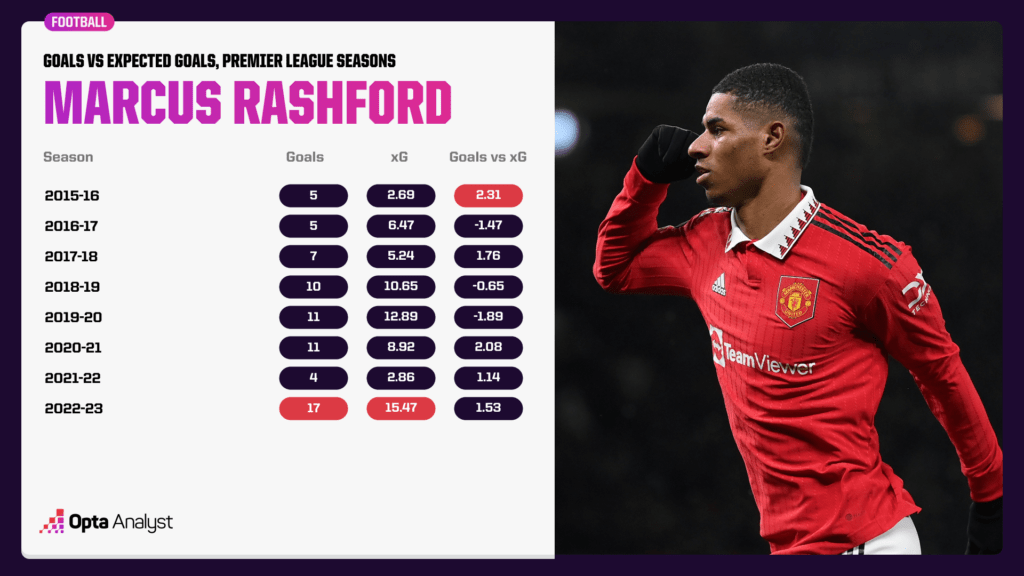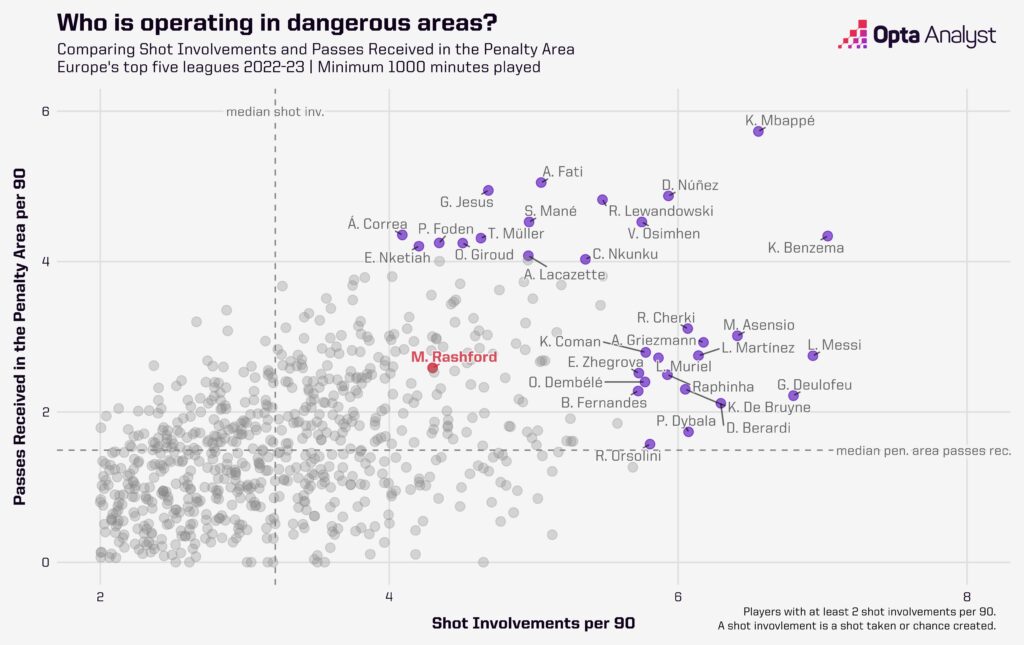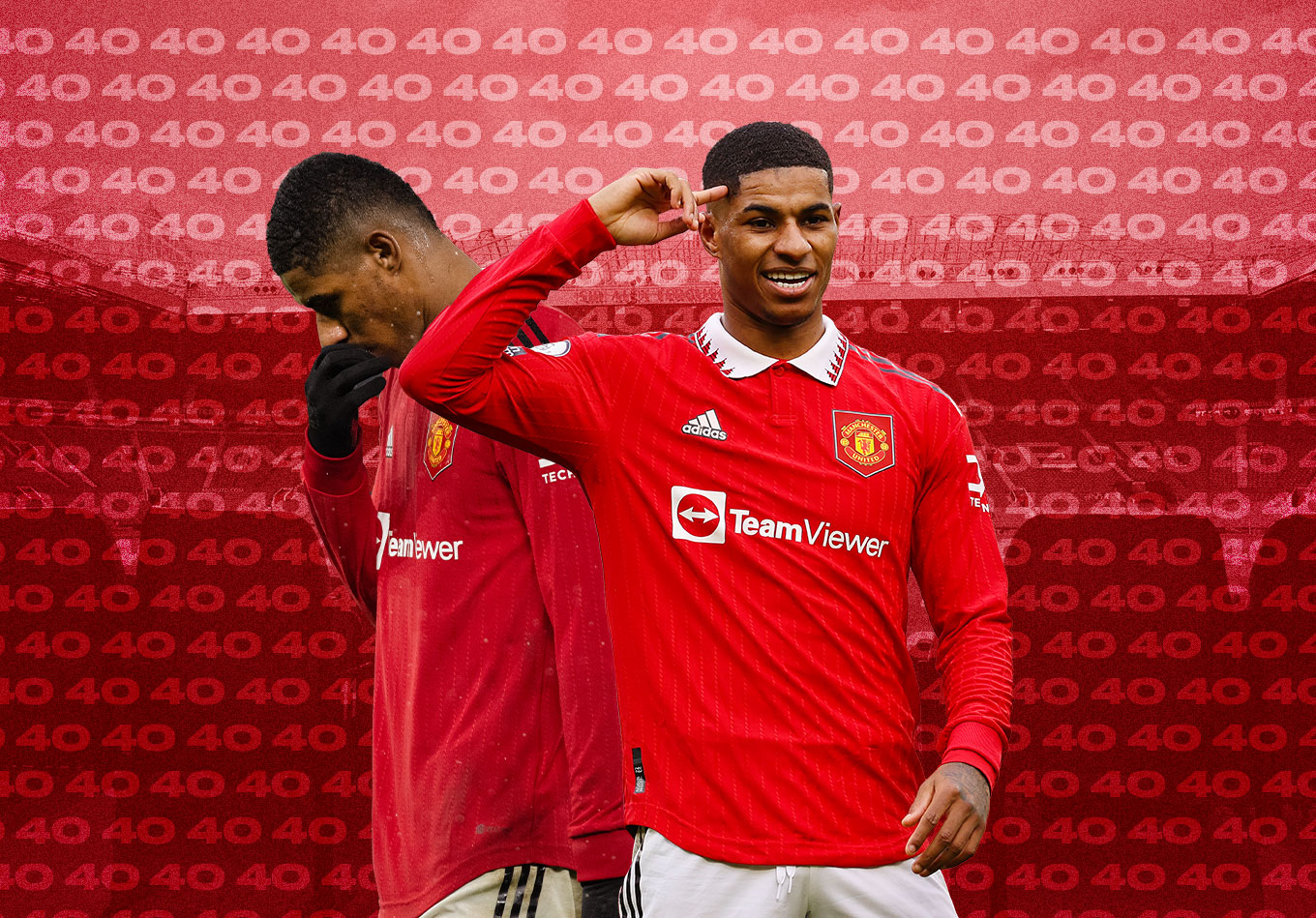With news of Marcus Rashford committing his future to Manchester United by signing a new contract, we look at whether he can live up to the challenge Erik ten Hag set him last season
After Marcus Rashford made it 30 goals for the 2022-23 season with his 78th-minute strike against Chelsea in late May, manager Erik ten Hag quickly set about demanding more from his forward.
“I think Marcus is capable of scoring 40 goals in a season,” he said. “For him, that’s the next step.”
That’s some challenge, particularly for a player who, despite his many talents has never truly convinced as a number nine, and whose form has remained patchy even in a 30-goal season.
“I think there is more to come from Marcus,” Ten Hag continued. “There’s a lot of room for improvement in his game and I’m convinced he can score even more. When you take, for instance, the last 10 games he didn’t score many goals.”
Ten Hag is right in that there was an obvious slump in Rashford’s form; a period during which there was clear room for improvement.
There was a time earlier in the campaign when it seemed as though Rashford would never stop scoring. After coming back from the World Cup in Qatar – where he scored three goals for England – he hit 16 goals and got four assists in 17 games for United. At that stage, United were flying and there wasn’t much reason for Ten Hag to go big on a forward in the transfer market. Rashford was playing so well and United were winning so many games that not only did it feel like a new signing was unnecessary, there was also the possibility than a new arrival would stymie Rashford’s progress. United had a homegrown goal machine who was finally reaching his potential with the club he loved. What more could they possibly need?

Back in late February, after Rashford scored in a 2-0 win over Leeds, United moved to within five points of leaders Arsenal, and for a few hours even went ahead of rivals Manchester City into second. There were even (debateable) suggestions they had moved into the title race.
Soon after, however, Rashford’s goals dried up. And so did United’s form. They fell away terribly and although they finished third, there was a time towards the end of the season when Liverpool fancied their chances of pipping United to fourth.
There had been an overreliance on Rashford’s goals earlier in the campaign, and a 40-goal forward can’t go through the kind of lull that he did. After that free-scoring run in mid-season, Rashford managed just six goals in 19 games up to and including the final game in the Premier League last Sunday. Looking at his five-game rolling totals for goals versus expected goals, there was a significant period when he was outperforming his underlying numbers, but there were also times when he was underperforming, and there was a stark drop-off after February 19th. Clearly, that is the period when an improvement is needed, and when a 40-goal forward’s goals simply wouldn’t fall so dramatically.
So, the question is: can Rashford be the goalscorer Ten Hag wants him to be?
Firstly, it’s key to point out that, even though the United manager played Rashford as a nine for a decent chunk of the season and in many of United’s biggest games – against Man City, Arsenal, Liverpool, Barcelona, Chelsea and Tottenham, for example – it appears as though Rashford’s future is on the flank. The persistent rumours about interest in Rasmus Højlund would suggest as much.
But whether or not Rashford plays through the middle, Ten Hag wants the burden of goals spread around the team more evenly. He will be more aware than anyone of how much his team suffered when Rashford’s form dipped.
“What we need besides Marcus Rashford is one extra player with scoring abilities,” Ten Hag said. “Whether it’s coming out of our own squad or we have to sign one.”
United’s second highest scorer in the Premier League this season was Bruno Fernandes, with eight goals, two of which were penalties. Rashford needs more support, but his threat in front of goal is improving. He has just had by a distance his best goalscoring season, with 17 goals; he did also score 17 Premier League goals in 2019-20 but his numbers were boosted by six penalties. It is important to note here quite how significant it is that Rashford isn’t United’s first-choice penalty-taker (he did score one this season – in the FA Cup against Everton), and yet he is still being challenged to score 40 goals a season. Kane, by way of comparison, scored 32 goals in all competitions this season, but six were from the spot. Take away penalties and Rashford has more goals this season than Kane.
A look at Rashford’s numbers show just how much more of a threat he has become. In 2022-23, he had 3.4 non-penalty shots per 90 in Premier League games, which was his highest in any season so far in his career. Not only that, his expected goals (xG) per 90 was also at its highest (0.48) in any season to date, and his non-penalty big chances per 90 was also higher than ever before – averaging more than one per full game (1.09).
His xG per non-penalty shot was higher than in either of the previous two campaigns, but this season is only the fourth best of his career in this regard.
So, the shots he is having these days are not massively higher-quality chances than before, but he is having so many more shots that his threat is far greater. That explains his increased goal output. The combination of the frequency of shots and quality of the positions he is getting into have meant he is scoring goals more often.
That said, he still isn’t a truly elite finisher. Although his 12 non-penalty goals in cup competitions came from just 7.54 xG, his 17 Premier League goals this season came from 15.5 xG. Against top-level opposition, he is only just a better-than-average finisher. And that is a consistent theme across his entire career.

His overperformance compared to his xG of 1.53 in 2022-23 was the fourth best of his career, but the best is only marginally better, at 2.31 in 2015-16. His actual goal tally has never been drastically above his xG tally, and it has also never dipped too far below. Over the course of his entire Premier League career, he has outscored his xG by 4.81. By comparison, Kane scored his 25 non-penalty Premier League goals in 2022-23 from just 16.7 xG.
Rashford tends to score at something like an average rate, and just about did that again this season, even as he went on that sensational scoring run through the winter months and had his best season in front of goal.
The difference for Rashford in 2022-23 was that he got into dangerous positions more often and that led to more goals. The next step for him would be to further increase the volume of chances he is getting.
He is still only 25, so could still improve his finishing to start outscoring his xG like an elite goalscorer, but the evidence so far in his career is that this isn’t an area of the game that he shines in. It might not be where he improves.
Bringing in a centre-forward who scores goals consistently could actually help Rashford become even more prolific. He would benefit from having less pressure on him to score on a weekly basis, and the presence of a bigger goal threat in central areas will take some of the opposition’s attention away from him. That could allow him to receive closer to goal more often and get more shots off. We’ve seen that Rashford has required more shooting opportunities rather than better ones to score more goals, and a striker who drags centre-backs out of position by receiving to feet, creating space centrally, will only help that. As the below graphic shows, Rashford has a way to go if he is to join the game’s elite when it comes to receiving in dangerous areas and shooting often.

Ten Hag wants to build a front three in the mould of Arsenal’s current attack line, and not entirely dissimilar to Tottenham’s. That will mean a centre-forward who is happy dropping to receive (such as Gabriel Jesus or Kane), a dribbler or creator on the right (such as Bukayo Saka or Dejan Kulusevski), and a quick, direct goal threat on the left (such as Gabriel Martinelli or Son Heung-min). With the addition of a number nine who scores more goals than the functional but rather limited Wout Weghorst did, Rashford could become even more threatening.
Whether he can ever make it to 40 goals is another matter – particularly considering he doesn’t even take penalties for United. Sharing the load will only help him out.
Enjoy this? Subscribe to our mailing list to receive exclusive weekly content. And follow us on Twitter too.
